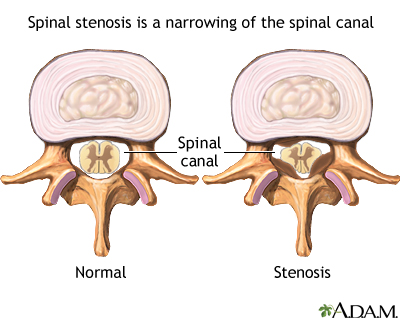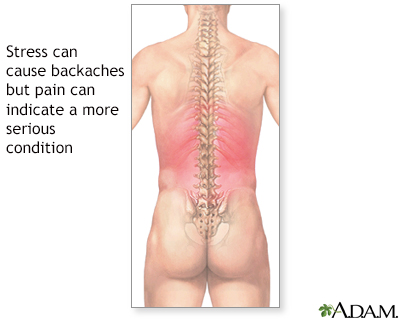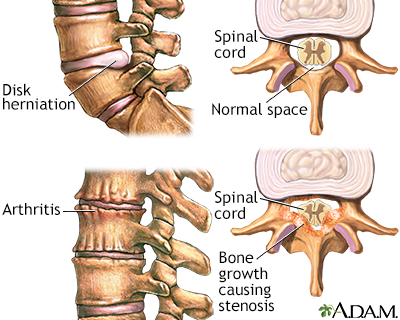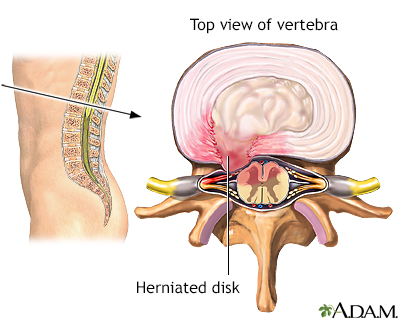Low back pain - chronic
Nonspecific back pain; Backache - chronic; Lumbar pain - chronic; Pain - back - chronic; Chronic back pain - low
Low back pain refers to pain that you feel in your lower back. You may also have back stiffness, decreased movement of the lower back, and difficulty standing straight.
Low back pain that is long-term is called chronic low back pain.

You might have heard a friend say that they have slipped a disk. Or, you may have slipped a disk yourself during an overly strenuous workout, or by straining while lifting something heavy. A slipped disk can be painful, so painful, in fact, that you can barely move. But what exactly is a slipped disk? And what can you do about it if you have one? This is your spine. In between the bones, which are called vertebrae, are little cushioning disks. These disks not only allow you to bend and move but also prevent your bones from rubbing against each other. Sometimes an injury can push a disk out of place, producing a bulge. This bulge is called a herniated disk. Or, a disk may break open. When a disk moves, it puts pressure on nearby nerves, and that's when you start to feel pain. Most slipped disks are found in the lower back or lumbar region, although you can also have one in your neck, or cervical region. When you have a slipped disk, you'll hurt, but often just on one side of your body. If the disk is in your lower back, you may feel a sharp pain in one part of your leg, hip, or buttocks. Your leg may also feel weaker than usual. If the disk is in your neck, the pain and numbness can stretch all the way from your neck down to your shoulder and arm. You may notice that it hurts even more when you stand for a long period of time, or if you sneeze, cough, or laugh. So, how do you treat a slipped disk? First your doctor will want to make sure that you actually have a slipped disk. To find out, the doctor will check your muscle strength, feeling, and reflexes, and have you move in different ways, for example, by bending, standing, and walking. You may also have a scan to find the exact location of the slipped disk. While bed rest was once the standard therapy for low back pain, studies show that for most people it does not help and may even make the situation worse. Rapid return to healthy normal activity is usually best, being careful not to put too much stress on the back. While you're doing that, you can take medicines like ibuprofen or aspirin to relieve the pain. Muscle relaxants may also help. Acupuncture, massage, and yoga have also been shown to be affective in some studies. Physical therapy may be helpful after the first two or three weeks. It can help strengthen the muscles of your spine, and teach you how to move properly so you don't injure yourself again. If these measures don't help, your doctor may suggest getting steroid injections into the area where you slipped the disk, to reduce pain and relieve swelling. As a last resort when all other treatments have failed, you may have a surgery called a diskectomy to remove the damaged disk. You may be in pain now, but don't despair, with treatment it should ease. Realize that it may take a few months before you're back to your old self. Don't try to overdo it by bending or doing any heavy lifting. You'll just wind up back on your couch, hurting again.

Spinal stenosis is narrowing of the spinal canal. This can develop as you age from drying out and shrinking of the disk spaces. (The disks are 80% water.) If this happens, even a minor injury can cause inflammation of the disk and put pressure on the nerve. You can feel pain anywhere along your back or leg(s) that this nerve supplies.

When you get up from a chair or take a walk, do you feel pain in your back, legs, shoulders, or arms? Do your arms or legs feel weaker than usual? If so, believe it or not, the problem could be in your spine, and the cause, a condition known as condition called spinal stenosis. Your spine is the column of bones that runs up the center of your back. It not only helps you stay upright but also flexes to allow you to bend and twist. These bones are called vertebrae, which are separated by spongy disks that cushion the bones so they don't rub against each other. As you get older, these spongy disks start to shrink, while the ligaments of your spine may swell up, due to arthritis. Together, these two actions narrow and put pressure on your spinal cord, or its exiting nerves, which is called spinal stenosis. You can also get spinal stenosis if you've had an injury like a slipped disk. So, how is spinal stenosis diagnosed? During an exam, your doctor will try to find the source of your pain or weakness by having you go through different motions. You'll sit, stand, walk, bend forward and backward, and lift your legs. The doctor will probably also test your reflexes with a rubber hammer, and use a feather or pin to see whether you've lost any feeling in feet and legs. Although there are surgical procedures to relieve the pressure on your spinal cord, trying a few measures at home first can help you avoid surgery. Physical therapy will teach you exercises and stretches to strengthen your muscles and improve your range of motion. Massage and acupuncture can be helpful for relieving back and neck pain. Putting heat or ice on a painful area can also help. Or, your doctor may recommend taking anti-inflammatory or pain-relieving medications. You can probably stay active with spinal stenosis, if you follow your doctor's recommendations and don't try to overdo it. Maybe you need to walk instead of jog, or play fewer holes on the golf course. If treatments at home don't work, surgery can often help relieve your symptoms, although it doesn't cure the condition and your pain may come back afterward. One of the biggest worries with spinal stenosis is numbness. If you can't feel pain in your legs or feet, you may get injured and not even realize it. An untreated injury can lead to an infection. Make sure to call your doctor if you have any numbness, pain, or other symptoms of spinal stenosis, especially trouble balancing or difficulty urinating or having a bowel movement. Take care of your spine. It's the only one you've got.

Although stress can cause backaches it is wise to watch out for other signs that may indicate a more serious condition. Pain which radiates to the buttocks, arms or legs, and weakness or numbness in the arms and legs should not be ignored.

Sciatica. It's not a new trendy restaurant in New York or LA, or a new SciFi program on your favorite cable channel. Sciatica is something much less sexy. Sciatica might actually be the cause of that the sharp pain you occasionally feel in your backside, or traveling down your hip or leg. What is sciatica? What does this pain mean? Sciatica occurs when there is pressure or damage to the Sciatic nerve. This large nerve starts in your lower spine and runs down the back of each leg. It controls the muscles of the back of your knee and lower leg. It also provides sensation to the back of your thigh, part of your lower leg, and the sole of your foot. Sciatica is usually caused by another problem, such as a slipped disk, spinal stenosis or narrowing of the spinal column, piriformis syndrome, the narrowing of muscle in your buttocks, a pelvic injury or fracture, and perhaps even tumors. Your pain may feel like a mild tingling, a dull ache, or a burning sensation. Sometimes the pain can be so bad you might not be able to move. The pain will usually occur on one side, perhaps as a sharp pain in one part of your hip or leg, or maybe you will notice the numbness. The pain may get worse after you stand or sit, at night, when you sneeze, cough, or laugh, or when you bend backwards or walk forward. For treatment, your doctor will perform a careful physical exam. Your doctor might find you have weakness when you bend your knee or move your foot, trouble bending your foot inward or downward, weak reflexes, or pain when you lift your leg straight up off the examination table while lying down. Your doctor may also do other tests to find what's causing your sciatica, including blood tests, x-rays, and other imaging tests. Treatment will focus on what causes your sciatica. Sometimes you may not need treatment because your pain will go away on its own. Your doctor will likely first recommend that you take steps to calm your symptoms and reduce inflammation, such as applying heat or ice to the painful area. You might try ice for the first 48 to 72 hours after you feel pain, then use heat afterwards. Your doctor might also tell you to take over-the-counter pain relievers. If conservative measures don't help your problem, your doctor may recommend you have injections to reduce inflammation around your sciatic nerve and other medicines to reduce the stabbing pain. Physical therapy may be a viable option, so talk to your healthcare provider about this option. Whatever you do, don't stay in bed all day. You need to reduce your normal activity for the first few days after you start having pain, but getting no activity will only make your pain worse. After a few days, try gradually returning to your normal routine. But, avoid heavy lifting or twisting your back for at least 6 weeks. Make sure you start exercising again though after 2 to 3 weeks. Remember, include exercises to strengthen your abdomen or belly and improve the flexibility of your spine.

Most people age 50 and older have experienced low back pain. This is caused by age-related wear and tear of the spinal disks, joints, and other spinal structures. As we age, the soft disks between the vertebrae dry out and start to bulge and can rupture. This condition is called disk herniation. Arthritis of the spine causes the bones and ligaments of the spine to thicken and grow larger. Arthritis and herniated disks can contribute to spinal stenosis, which is narrowing of the spinal column. This causes pressure on the spinal cord and the nerves that leave the spinal column. These age-related changes to the spine can cause pain, weakness, or numbness.

A herniated (slipped) disk occurs when part or all of the soft, gelatinous portion of a disk is forced through a weakened part of the disk. The disk may move out of place (herniate) or break open (rupture) from injury or strain. This can put pressure on nearby nerves or the spinal cord. This can happen to any part of the spine, but it most often occurs in the lower back. A herniated disk in the lower back may cause low back pain that radiates across the hips or to the ankle or foot. If the disk herniation is minimal, you may have no symptoms. Most people improve with nonsurgical treatment, but it may take several months or a year or more to return to all of your activities without having pain.
Causes
Low back pain is common. Almost everyone has back pain at some time in their life. Often, the exact cause of the pain cannot be found.
A single event may not have caused your pain. You may have been doing many activities, such as lifting the wrong way, for a long time. Then suddenly, one simple movement, such as reaching for something or bending from your waist, leads to pain.
Many people with chronic back pain have arthritis. Or they may have extra wear and tear of the spine, which may be due to:
- Heavy use from work or sports
- Injuries or fractures
- Surgery
You may have had a herniated disk, in which part of the spinal disk pushed onto nearby nerves. Normally, the disks provide space and cushion in your spine. If these disks dry out and become thinner and more brittle, you can lose movement in the spine over time.
If the spaces between the spinal nerves and spinal cord become narrowed, this can lead to spinal stenosis. These problems are called degenerative joint or spine disease.
Other possible causes of chronic low back pain include:
- Curvature of the spine, such as scoliosis or kyphosis
- Medical problems, such as fibromyalgia or rheumatoid arthritis
- Piriformis syndrome, a pain disorder involving a muscle in the buttocks called the piriformis muscle
You are at greater risk for low back pain if you:
- Are over age 30
- Are overweight
- Are pregnant
- Do not exercise
- Feel stressed or depressed
- Have a job in which you have to do heavy lifting, bending and twisting, or that involves whole body vibration, such as truck driving or using a sandblaster
- Smoke
Symptoms
Symptoms may include any of the following:
- Dull aching pain
- Sharp pain
- Tingling or burning sensation
- Weakness in your legs or feet
Low back pain can differ from person to person. The pain may be mild, or it can be so severe that you cannot move.
Depending on the cause of your back pain, you may also have pain in your leg, hip, or on the bottom of your foot.
Exams and Tests
During the physical exam, your health care provider will try to pinpoint the location of the pain and figure out how it affects your movement.
Other tests you have depend on your medical history and symptoms.
Tests may include:
- Blood tests, such as a complete blood count and erythrocyte sedimentation rate
- CT scan of the lower spine
- MRI scan of the lower spine
- Myelogram (x-ray or CT scan of the spine after dye has been injected into the spinal column)
- X-ray of the lumbosacral spine
Treatment
Your back pain may not go away completely, or it may get more painful at times. Learn to take care of your back at home and how to prevent repeat episodes of back pain. This can help you continue with your normal activities.
Your provider may recommend measures to reduce your pain, including:
- A back brace to support your back
- Cold packs and heat therapy
- Traction
- Physical therapy, involving stretching and strengthening exercises
- Counseling to learn ways to understand and manage your pain
These other providers may also help:
- Massage therapist
- Someone who performs acupuncture
- Someone who does spinal manipulation (a chiropractor, osteopathic physician, or physical therapist)
If needed, your provider may prescribe medicines to help with your back pain:
- Aspirin, naproxen (Aleve), or ibuprofen (Advil), which you can buy without a prescription
- Low doses of prescription medicines
- Narcotics or opioids when the pain is severe
If your pain does not improve with medicine, physical therapy, and other treatments, your provider may recommend an epidural injection.
Spinal surgery is considered only if you have nerve damage or bone damage that is causing the back pain does not heal after a long time.
In some people, a spinal cord stimulator can help reduce back pain.
Some people with low back pain may also need:
- Job changes
- Job counseling
- Job retraining
- Occupational therapy
Outlook (Prognosis)
Most back problems get better on their own. Follow your provider's advice on treatment and self-care measures.
When to Contact a Medical Professional
Contact your provider if you have severe back pain that does not go away. Contact them right away if you have numbness, loss of movement, weakness, or bowel or bladder changes.
References
Abd OHE, Amadera JED. Low back strain or sprain. In: Frontera WR, Silver JK, Rizzo TD Jr, eds. Essentials of Physical Medicine and Rehabilitation: Musculoskeletal Disorders, Pain, and Rehabilitation. 4th ed. Philadelphia, PA: Elsevier; 2019:chap 48.
Dixit R. Low back pain. In: Firestein GS, McInnes IB, Koretzky GA, Mikuls TR, Neogi T, O'Dell JR, eds. Firestein & Kelley’s Textbook of Rheumatology. 12th ed. Philadelphia, PA: Elsevier; 2025:chap 47.
Ibrahim M, Hurlbert RJ. Nonsurgical and postsurgical management of low back pain. In: Winn HR, ed. Youmans and Winn Neurological Surgery. 8th ed. Philadelphia, PA: Elsevier; 2023:chap 312.
Version Info
Last reviewed on: 4/1/2025
Reviewed by: Linda J. Vorvick, MD, Clinical Professor Emeritus, Department of Family Medicine, UW Medicine, School of Medicine, University of Washington, Seattle, WA. Also reviewed by David C. Dugdale, MD, Medical Director, Brenda Conaway, Editorial Director, and the A.D.A.M. Editorial team.
